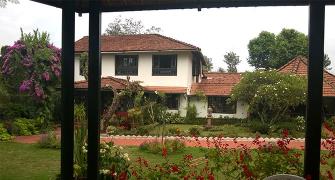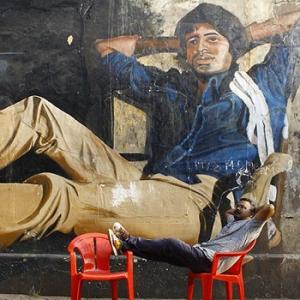'Bateshwar is a rare temple where Shiva is depicted in his human form (and not his symbol, the Lingam).'
Geetanjali Krishna visits a town famous for its temples.
Illustration: Dominic Xavier/Rediff.com

It's a quiet, sunny morning in Bateshwar.
There isn't a soul in sight and the only sign of human activity one can see is a plume of smoke rising up from the top of a ravine.
"It's from a house inside the hill," the driver says. "The old baba always cooks his lunch outside."
So off I go a steep, sandy path to the top, where the dry sand has been watered and hardened to the texture of a clay tennis court.
There, under a scraggly old tree, the sadhu sits with his disciples and a couple of chillums, watching the proverbial pot boil on an open hearth.
The smoke is too heady to be emanating from the pot of dal hanging over the fire.
It seems strangely fitting that the house inside the hill looks like it too belongs in a hazy dream.
I gaze at its door embedded into the ravine, wondering if a hobbit would emerge, if it were to open.
The sadhu imperiously motions for me to come over.
"Would you like to see my house?" he asks. "Take off your shoes and explore it... I don't mind."
Barefoot, I enter a large, spartan room which is surprisingly cozy.
"Living underground is a little like living inside an earthen pot," says the sadhu. "The mud insulates my home, so it's cool all summer and cozy in the winter."
A maze-like warren of smaller rooms, dark and unused, lies ahead.
"I don't need so much space, so I don't use them," he says.
The ravines of Chambal, he tells me, are riddled with such houses.
"I've lived here in this beehad ravine for almost ten years now," he says.
The sunlight, when I finally emerge outside, is blinding.
As I walk away from the sadhu's house, I notice many other doors pockmarking the ravines ahead.
It's a veritable neighbourhood of hobbit houses, I muse.
The scrub is thin, and the soil too sandy to be fertile. No wonder ravines are believed to be some of the world's most degraded landscapes.
Created millennia ago when the Chambal river was forced to change course, its channels carving furrows that have become deeper with time, the ravines are a barren yet strangely charming habitat.
Charming, until the driver begins narrating gory stories of crime -- and no punishment -- in these parts.
"Dacoits used to know these ravines like the back of their hands at one time and could easily outwit the authorities," said he. "But they're all gone now, replaced by petty two-wheeler thieves. Since there's no knowing where these ravines and the burrows within them lead, the police are rarely able to catch them."
Suddenly, I'm uncomfortably conscious of the solitude around.
The distant clang of temple bells reminds me I've yet to visit Bateshwar's splendid complex of hundred-odd temples on the banks of the river Yamuna.
Bateshwar is an immensely sacred place in Agra district, a rare temple where Shiva is depicted in his human form (and not his symbol, the Lingam).
It also hosts a month-long religious fair attended by sadhus, pilgrims, traders and tourists alike. The rest of the time, however, it's a sleepy hamlet with a multitude of temples bearing a look reminiscent of a lover waiting for his beloved.
We walk through the scrub, akin to what dacoits of yore might have done in the past, raising sand with our feet.
Finally, we reach the main temple, where Shiva is worshipped as Bateshwar, Lord of the banyan tree.
It is festooned with countless bells, most which are larger than any I've seen earlier, suspended by devotees.
Outside the temple, from the ghat, the multitude of temples is visible.
Some have inscriptions glorifying their builders, but most have been built by anonymous patrons.
A young tourist finds a sunny spot on the ghat and pulls out his sketchbook.
Two local women descend the steps for a ritual bath.
I sit down as well, and am struck by how different the temples are, in terms of architectural style, provenance and level of grandeur -- and yet, they are all dedicated to the same god.
If only we learned to accept modern diversity with the same simplicity, I wonder.
And just then, quite fittingly, the sun disappears into the Yamuna without much ado.










